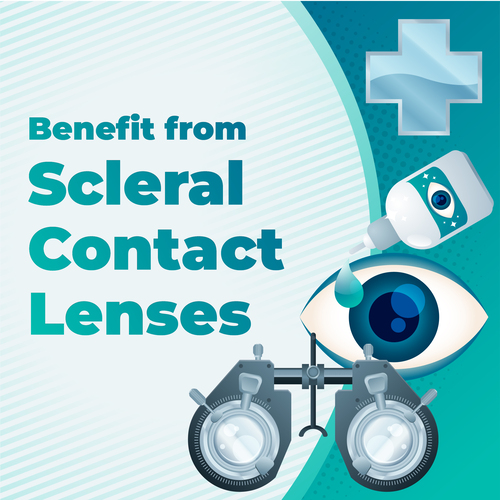Scleral Contact Lenses: A Revolution in Eye Care
Scleral contact lenses offer a transformative solution for individuals with various corneal conditions and those seeking enhanced vision correction. Unlike traditional lenses, scleral lenses rest on the sclera (the white part of the eye) and create a fluid-filled reservoir over the cornea. This unique design makes them highly comfortable, especially for people with irregular corneas, severe dry eyes, or conditions like keratoconus.
What Makes Scleral Contact Lenses Unique?
Scleral contact lenses differ significantly from conventional soft or rigid gas-permeable (RGP) lenses. Their larger size allows them to vault over the cornea and rest on the sclera, eliminating any direct contact with the sensitive corneal surface. This design enhances comfort and protects the cornea from external irritants, which is crucial for individuals with compromised corneal health.
The fluid-filled reservoir between the scleral contact lens and the cornea helps maintain constant hydration. For people suffering from dry eyes, this is a game-changer, as scleral contact lenses provide relief from discomfort and promote healing of the corneal surface.
Who Can Benefit from Scleral Contact Lenses?
Scleral contact lenses are ideal for people with various eye conditions that make wearing traditional lenses challenging. These lenses can benefit individuals with the following:
- Keratoconus: A condition where the cornea becomes thin and cone-shaped, leading to distorted vision. Scleral contact lenses provide a smooth optical surface, improving vision dramatically.
- Severe Dry Eye: Conditions like Sjögren’s syndrome or other tear-deficiency disorders can cause extreme dryness. The fluid layer of scleral contact lenses offers constant lubrication, alleviating the discomfort associated with dry eyes.
- Irregular Corneas: Whether caused by surgery, trauma, or disease, irregular corneas can make it difficult to achieve clear vision with glasses or regular lenses. Scleral contact lenses create a uniform surface, helping to correct these irregularities.
- Post-Surgical Eyes: After corneal surgeries like transplants or LASIK, scleral contact lenses can aid in vision rehabilitation, providing comfort and enhanced visual acuity.
- Ocular Surface Diseases: Conditions like Stevens-Johnson syndrome or chronic allergies may affect the eye’s surface. Scleral contact lenses protect the cornea from exposure to environmental elements and irritants.
Why Choose Scleral Contact Lenses?
Scleral contact lenses provide a superior alternative for individuals who have struggled with other forms of vision correction. Their ability to cater to complex eye conditions makes them highly sought-after by patients seeking comfort, protection, and visual clarity.
- Comfort: Because scleral contact lenses sit on the sclera, they bypass the sensitive corneal surface, offering unparalleled comfort, even for those with corneal sensitivity.
- Stability: Scleral lenses are larger than conventional lenses, so they remain stable on the eye. This stability ensures consistent, clear vision throughout the day.
- Protection: The fluid reservoir between the scleral contact lens and the cornea not only hydrates but also serves as a barrier, protecting the eye from dust, debris, and allergens.
- Custom Fit: Each scleral contact lens is custom-designed to fit the unique curvature of the wearer’s eye. This customization ensures a precise fit, improving both comfort and vision correction.
- Long-Term Wear: Many users find that scleral contact lenses can be worn comfortably for extended periods, making them ideal for people who require all-day vision correction.
Are Scleral Contact Lenses Right for You?
If you suffer from any corneal irregularities, dry eyes, or are seeking a more comfortable vision correction solution, scleral contact lenses may be the perfect option. Consulting with an eye care specialist is the first step toward determining if these lenses are right for you.
Fitting Process for Scleral Contact Lenses
Getting fitted for scleral contact lenses requires a detailed evaluation by an optometrist or ophthalmologist. The process involves taking precise measurements of the eye to ensure that the scleral contact lens is crafted to fit perfectly. Advanced imaging technologies are often used to map the surface of the cornea and sclera, ensuring the lens provides both comfort and optimal vision correction.
Once your scleral contact lens is fitted, your eye care provider will guide you on how to insert, remove, and care for the lenses. Proper maintenance is crucial for ensuring long-lasting wear and maintaining eye health.
Conclusion
Scleral contact lenses have revolutionized vision correction for people with complex corneal conditions. Their innovative design, comfort, and ability to provide clear, stable vision make them an excellent choice for anyone seeking a more advanced and reliable solution. With the right fit and proper care, scleral contact lenses can significantly improve your quality of life, offering clarity and comfort you may not have experienced with other lenses.



